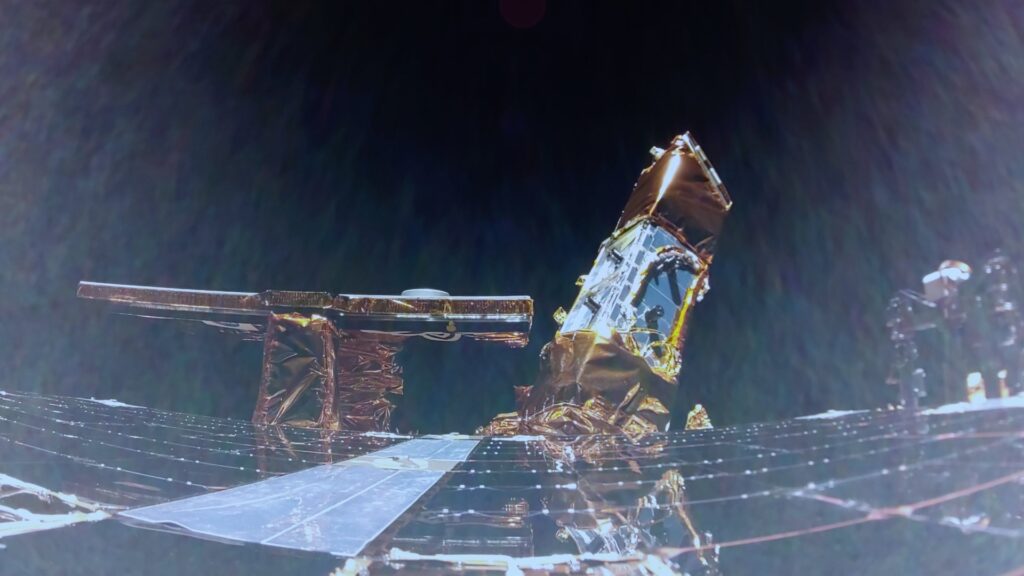NASA spacecraft launched toward Jupiter’s Europa to see if ice-covered moon could host life

NASA spacecraft launched toward Jupiter’s Europa to see if ice-covered moon could host life
NASA finally launched a spacecraft from Florida on Monday on a mission to examine whether Jupiter’s moon, Europa, has conditions suitable to support life. The launch had been delayed a week due to Hurricane Milton.
Europa Clipper launch Monday the start of a mission expected to last nearly 10 years
Thomson Reuters
·
NASA launched a spacecraft from Florida on Monday on a mission to examine whether Jupiter’s moon Europa has conditions suitable to support life, with a focus on the large subsurface ocean believed to be lurking beneath its thick outer shell of ice.
The U.S. space agency’s Europa Clipper spacecraft blasted off from the Kennedy Space Center in Cape Canaveral on a SpaceX Falcon Heavy rocket under sunny skies. The robotic solar-powered probe is due to enter orbit around Jupiter in 2030 after journeying about 2.9 billion kilometres in 5½ years.
The launch was planned for last week but delayed because of Hurricane Milton.
It is the largest spacecraft NASA has built for a planetary mission, at about 30.5 metres long and about 17.6 metres wide, with its antennas and solar arrays fully deployed — bigger than a basketball court — while weighing approximately 6,000 kilos.
Even though Europa, the fourth largest of Jupiter’s 95 officially recognized moons, is just a quarter of Earth’s diameter, its vast global ocean of salty liquid water may contain twice the water in Earth’s oceans — thought to have been the birthplace for life on our planet.
Europa, whose diameter of roughly 3,100 kilometres is approximately 90 per cent that of our moon, has been viewed as a potential habitat for life beyond Earth in our solar system. Its icy shell is believed to be 15 to 25 kilometres thick, sitting atop an ocean 60 to 150 kilometres deep.
Europa could be habitable, scientists believe
NASA associate administrator Jim Free told a prelaunch briefing on Sunday that Europa boasts one of the most promising environments for potential habitability in our solar system, beyond Earth, though he noted this mission will not be a search for any actual living organisms.
“What we discover on Europa,” Free said, “will have profound implications for the study of astrobiology and how we view our place in the universe.
“Scientists believe Europa has suitable conditions below its icy surface to support life. Its conditions are water, energy, chemistry and stability,” said Sandra Connelly, deputy associate administrator of NASA’s science mission directorate.
Among the mission objectives are measuring the internal ocean and the layer of ice above it, mapping the moon’s surface composition, and hunting for plumes of water vapor that may be venting from Europa’s icy crust. The plan is for Europa Clipper starting in 2031 to conduct 49 close flybys of Europa over a span of three years, coming as close as 25 kilometres to the moon’s surface.
Europa Clipper will operate in an intense radiation environment around Jupiter, our solar system’s biggest planet.
Jupiter is enveloped by a magnetic field about 20,000 times stronger than Earth’s. This magnetic field spins, capturing and accelerating charged particles and creating radiation that could harm spacecraft. NASA fashioned a vault made of titanium and aluminum inside the Europa Clipper to protect its sensitive electronics from this radiation.
LISTEN | Inside the details of the new mission to Europa:
Quirks and Quarks9:00A new NASA mission will search for signs of life on a Jovian ice moon
Next week NASA hopes to launch a major mission to one of Jupiter’s most fascinating moons. The Europa Clipper will visit the ice moon Europa, whose icy shell is thought to cover an ocean that could contain twice the water that’s in all of Earth’s oceans. The fascination with Europa is based on the idea that water is an essential ingredient for life. As a result, Europa could be one of the most promising places in our solar system for life to exist. We talk about the upcoming mission with Cynthia Phillips, the Project Staff Scientist and Planetary Geologist at NASA’s Jet Propulsion Laboratory.
“One of the Europa Clipper mission’s main challenges is delivering a spacecraft hardy enough to withstand the pummelling of radiation from Jupiter but also sensitive enough to gather the measurements needed to investigate Europa’s environment,” Connelly said.
NASA said Europa Clipper is loaded with more than 2,750 kilograms of propellant to get it to Jupiter. For the launch, the spacecraft was placed inside the protective nose cone atop the rocket.
The spacecraft will not take a straight path to Jupiter. Instead, it is due to fly by Mars, then back by Earth, using the gravity of each planet to increase its momentum like a slingshot. Its expansive solar arrays, which were folded up for the launch, will gather sunlight for powering the spacecraft’s nine scientific instruments as well as its electronics and other subsystems.
Discover more from Tamfis Nigeria Lmited
Subscribe to get the latest posts sent to your email.



 Hot Deals
Hot Deals Shopfinish
Shopfinish Shop
Shop Appliances
Appliances Babies & Kids
Babies & Kids Best Selling
Best Selling Books
Books Consumer Electronics
Consumer Electronics Furniture
Furniture Home & Kitchen
Home & Kitchen Jewelry
Jewelry Luxury & Beauty
Luxury & Beauty Shoes
Shoes Training & Certifications
Training & Certifications Wears & Clothings
Wears & Clothings
















